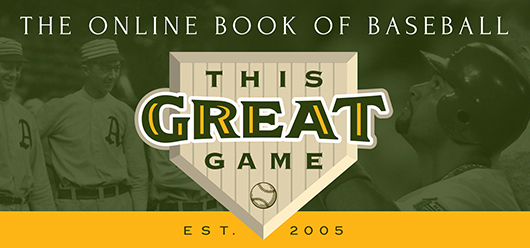THE TEAMS
The Guardians’ 10 Most Memorable Games
 October 4, 1948: You Do, Lou!
October 4, 1948: You Do, Lou!
After failing to win the American League pennant outright on the final day of the regular season, Cleveland had to face off against the Boston Red Sox—on the road, at Fenway Park—to determine the league champion in the junior circuit’s first-ever tiebreaker game.
The pitching matchup was interesting to say the least: Gene Bearden, enjoying the one and only solid campaign of his short career, was given the start for Cleveland despite having pitched a five-hit shutout just two days earlier; the Red Sox, meanwhile, were leaning on 36-year-old veteran Danny Galehouse, making his first start in three weeks—and, as it turned out, the last of his major league career.
The teams exchanged single runs in the first, and the tie held until the fourth when Cleveland opened it up with a three-run homer from third baseman Ken Keltner that ended Galehouse’s day for Boston; player-manager Lou Boudreau, who had homered to open the scoring in the first, added his second solo shot in the fifth to extend the lead. The Red Sox tried pecking away at Cleveland lead but only recovered to within three runs; solo runs in the eighth and ninth innings sealed the deal for the Indians, who won, 8-3. Bearden, showing no sign of fatigue despite pitching on a single day of rest, went the distance again, picking up his 20th win of the season; he never won more than eight in any of his other six major league years.
As he had all season long, Boudreau led by example, going 4-for-4 on the day with the two home runs to cap a MVP season in which he hit .355 with 18 homers and 106 RBIs. His performance both from the dugout and on the field proved critical for Cleveland as it advanced to the World Series and defeated the Boston Braves for its second—and last, to date—championship.
 April 16, 1940: Rapid Robert’s Rippin’ Start
April 16, 1940: Rapid Robert’s Rippin’ Start
Beginning his fifth major league season though still only 21, Bob Feller showed he was in peak form by throwing the majors’ only Opening Day no-hitter in history, blanking the White Sox 1-0 on a chilly spring day at Chicago’s Comiskey Park.
The White Sox nearly drew first blood on Feller through no fault of their own; the wild ace, known just as much for walking batters as he was for striking them out, filled up the bases on free passes, but rookie Bob Kennedy couldn’t handle Feller with two outs and struck out swinging to end the threat. Two innings later, Rollie Helmsley gave Cleveland and Feller all the offense they would need on the day when he tripled in Jeff Heath with the game’s only run.
Feller walked two other batters on the day, but he struck out eight and dodged some serious fire in the ninth when Luke Appling ripped four of his pitches—all of them ending up foul—before walking. Taft Wright, the last hope for the White Sox, then drilled a hard grounder that Cleveland second baseman Ray Mack knocked down and threw to first for the final out. Feller’s gem gave birth to the trivial question: Which team started a major league game with a .000 team batting average—and ended it still batting .000?
 October 10, 1920: Wambsganss Triples Up
October 10, 1920: Wambsganss Triples Up
After splitting the first four games of the 1920 World Series with Brooklyn, Cleveland took control in Game Five and never looked back thanks to several Series firsts and one of the single most incredible moments in Fall Classic history.
Cleveland wasted no time in the first inning; the first three batters reached to load the bases, and Elmer Smith emptied them when he connected off Brooklyn spitballer Burleigh Grimes for the first grand slam in World Series history. In the fourth, the Robins helped Cleveland turn a small threat into another big inning when, with one out and a runner at third, Grimes decided to walk eighth-place hitter Steve O’Neill to set up a possible double play with pitcher Jim Bagby coming to the plate. But Bagby, the 31-game winner of the regular season, turned the tables by launching a three-run homer—the first ever hit by a pitcher in Series annals—to make it a 7-0 lead. When Brooklyn next came up, they thought they had a turnaround rally when the first two batters reached—but reliever Clarence Mitchell, batting for himself, hit a line drive with the runners on the go—and the ball quickly found the glove of Cleveland second baseman Bill Wambsganss, who tagged Otto Miller between first and second and stepped on second to triple off Pete Kilduff and finish an unassisted triple play. It was a rare feat; only nine other such plays occurred in the majors during the 20th Century.
The Robins’ baserunning frustrations hardly ended with Wambsganss’ fielding gem; they hit into three other double plays, and two other players were caught attempting to steal. It answers the question of how, despite losing 8-1, the Robins were able to outhit Cleveland on the day, 13-12. With Bagby going the distance for his only Series win, the Indians took the Series lead and won the best-of-nine set in seven games for their first-ever championship.
 September 13, 2017: Forever 21
September 13, 2017: Forever 21
Predicted to run away with the AL Central title in 2017, Cleveland struggled through the season’s first four months to match expectations, barely clinging to first place against underwhelming competition. That all changed in late August when the team began playing as if they would never lose again.
Cleveland worked up a 20-game win streak into mid-September that tied the AL record set 15 years earlier by the Moneyball A’s of Oakland. The Indians weren’t just winning, they were annihilating; their average margin of victory during the streak was five runs, and they had hit more home runs than allowed total runs. Cleveland fans, who had been slow to warm up to this historic run, still couldn’t sell out Progressive Field; 7,000 unsold seats remained as the team prepared to hit 21 against the Detroit Tigers.
Slugger Jay Bruce, recently acquired from the New York Mets, jumped Cleveland quickly out in front with a first-inning, three-run homer. Mike Clevenger, a young, long-haired pitcher who excelled at quality starts of five-to-six innings, overcame an early run and kept the Tigers in knots before departing in the sixth. Up 4-3 at that point, Cleveland later got insurance in the seventh when catcher Roberto Perez belted a solo shot on a 0-2 count. The Tigers had one rally left in them, but failed to score as Bryan Shaw snuffed out the eighth-inning uprising and Cleveland prevailed, 5-3.
Cleveland’s streak would be extended to 22 the next night, breaking the all-time mark for the longest pure win streak—the 1916 New York Giants technically won 26 in a row, but there was a tie in the midst of that run—before finally bowing to Kansas City a day later, 4-3.
 April 8, 1975: Robbie’s Historic Debut
April 8, 1975: Robbie’s Historic Debut
Nearly three decades after Jackie Robinson broke the color barrier as the first black major leaguer of the modern era, baseball finally saw its first black manager when Frank Robinson was given the reins of the Indians and began the 1975 season as player-manager in style.
With Cleveland wearing bright new uniforms fully drenched in red from neck to ankle, Robinson himself set the pace against the New York Yankees when, during his first at-bat, he belted a first-inning home run to left field—thrilling the huge throng of 56,000 at Cleveland Stadium. The lead was short-lived as starter Gaylord Perry—embroiled in an egotistical tug-of-war with Robinson that later led to his early-season exit to Texas—gave up three second-inning runs to the Yankees. But the pinstriped rally would constitute the only real damage on Perry, who settled in, went the distance and allowed no more Yankee runs. Meanwhile, Cleveland fought back at the plate, tying the game in the fourth on a solo shot by Robinson’s fellow ex-Oriole teammate Boog Powell, and taking the lead in the sixth with Powell, again, doubling the first of two runs that would cap the scoring on the day. Although the Indians struggled to reach .500 for the season, the beautiful memories of Opening Day and the breaking of another color barrier will last long in the hearts of long-time Cleveland fans.
 October 26, 1997: The One That Got Away
October 26, 1997: The One That Got Away
Three outs away. Cleveland was just three not-so-simple outs away from winning its first championship in 49 years—and blew it. In the seventh game of a wild, sloppy and long series that brought ridicule from purists, pundits and NBC (which desperately wanted a short series so it could resume its higher-rated prime time programming), the Indians were buoyed for six-plus innings against the upstart Florida Marlins by starter Jaret Wright, who left with a 2-1 lead; In the ninth, the Marlins rallied against closer Jose Mesa—and succeeded in sending the game into overtime when Craig Counsell’s sacrifice fly brought in Moises Alou.
Still knotted in the bottom of the 11th, Florida’s Bobby Bonilla stroked a leadoff single off veteran Charles Nagy, making only the second relief appearance of his career. After Geoff Zahn popped a bunt to Nagy for the first out, Counsell next hit a grounder towards Fernandez—who misplayed the hop to turn a double play into a critical error. After an intentional walk and a force at home, Edgar Renteria batted with the bags loaded and two outs—and threaded the needle with an up-the-middle base hit that barely eluded half the Cleveland infield and brought home Counsell with the series-winning run, killing dreams of a long-awaited championship.
 June 4, 1974: Ten-Cent Beer Night
June 4, 1974: Ten-Cent Beer Night
In one of the ugliest episodes in major league history that recalled the rowdy hooliganism of the 1890s, the Indians battled the Texas Rangers to a 5-5 tie in the ninth inning—and then found themselves fighting together against a large mob of unruly Cleveland fans who had taken advantage of an ill-advised promotion in which cups of beer would be sold for 10 cents a piece.
Even before the 25,000 fans—double the season average—took their seats with their cheap beer, there was tension in the air between the two teams, who a week earlier engaged in a brawl-filled contest that itself nearly turned into a riot in Arlington. Now it was Cleveland’s turn. Throughout the game, fans interrupted the game in various ways; some shed their clothes and streaked around the field, while others threw objects toward the players. Rangers first baseman Mike Hargrove, the future Cleveland manager, just missed getting nailed by a wine jug. Inexplicably, Cleveland management did nothing to curb the growing alcohol-fueled antics of the fans, continuing to pour the beer with no increased security presence. Not even a bottom-of-the-ninth rally by Cleveland that tied the game and put the winning run on second base could appease the rowdier fans, who by now must have been out of their inebriated minds. When Rangers outfielder and star hitter Jeff Burroughs had his cap swiped by an onrushing fan—and tripped in pursuit of him—Texas manager Billy Martin, no stranger to confrontation, said enough and ordered his team out of the dugout, bats in hand, to deal with the issue.
That only made things worse; on cue, a flood of fans entered the field in attack mode, and even Cleveland—who a week earlier had made the Rangers its mortal enemies—decided it was time to come to the rescue of the Texas players. Numerous players from both teams were hit by objects and punches, though none were seriously hurt. Umpire crew chief Nester Chylak had no choice but to declare a forfeit with the game tied 5-5. Incredibly, only nine fans were arrested.
 October 17, 1995: Who’s Laughing Now?
October 17, 1995: Who’s Laughing Now?
With a wicked combination of ultra-talented homegrown players flanked by free agent veteran stars that produced a stunning 100-44 regular season mark, Cleveland shed their long-standing persona as clueless losers and clinched their first AL pennant in 41 years with the triumph of a tough ALCS against the upstart Mariners in Seattle.
The Game Six clincher proved to be a difficult task; the opposing pitcher was the great Randy Johnson, and the setting was a Kingdome packed with nearly 60,000 rabid fans who helped give the Mariners white-hot momentum as they stormed back from a 13-game regular season deficit to win the AL West. Undeterred, veteran Cleveland starter Dennis Martinez kept the potent Seattle offense locked down for seven innings, allowing just four hits and giving the team their chances to strike first on Johnson; in the fifth inning, they finally did, with an unearned run courtesy of Seattle second baseman Joey Cora’s error. But the Cleveland finally loaded up in the eighth when Carlos Baerga stroked a three-run shot that gave Cleveland a 4-0 lead. The bullpen took over from there, completing the shutout and sending the Indians, at long last, to their first World Series in generations.
 November 2, 2016: Inheriting the Burden of the Long-Suffering
November 2, 2016: Inheriting the Burden of the Long-Suffering
After clinching their first divisional title in nine years, Cleveland surprisingly mowed its way through the AL playoffs as a remarkably stout bullpen made up for an injury-riddled rotation to nullify the offensively potent Boston Red Sox and Toronto Blue Jays. Next came the World Series and a date with the powerful Chicago Cubs, equally blessed with a deep array of talented young hitters. It would be a highly anticipated pairing of the two teams with the longest World Series droughts: Chicago hadn’t won in 108 years, Cleveland in 68. Someone had to win.
Alas, poor Cleveland fans, fate would not be on your side.
With a 3-1 series lead, the Indians looked to be on the brink of snapping their long skid—but lost the next two games, setting up Game Seven at Cleveland. Home field advantage was neutralized as thousands of Cubs fans eager to witness history and a positive result invaded Progressive Field, and they made the most noise early on with the Cubs stretching out to a 5-1 lead in the fifth, Cleveland ace Corey Kluber—making his second straight start on three days’ rest—had little gas left in the tank. Neither, crucially, did super-reliever Andrew Miller, whose postseason effort to date had led to two wins, one save, five holds and just one run allowed in 17 innings with 29 strikeouts.
The Indians avoided irrelevancy in the bottom of the fifth when a Jon Lester wild pitch scored two runs and cut the Cleveland deficit in half. But the Cubs got one run back to make it a 6-3 game that held into the eighth, and things looked grim for Cleveland as stellar Chicago closer Aroldis Chapman took over for an attempted two-inning save. But like Kluber, Chapman was also pitching on fumes—and the Indians got to him, capping a three-run rally in the eighth when Rajai Davis rifled a line drive down the left-field line and over the tall wall. Cleveland’s newfound momentum would be watered down when a brief rain held up play for 17 minutes; when the game resumed, the Cubs rallied for two in the 10th—and the Indians’ desperate attempt to respond in the bottom of the frame led to one and only one run as the Cubs clinched an 8-7 win, ending their long dry spell—and continuing Cleveland’s as, for the moment, the majors’ longest.
 October 2, 1908: He’s Joss Perfect
October 2, 1908: He’s Joss Perfect
It’s one of the great pitching duels ever recorded: Chicago ultra-workhorse Ed Walsh, looking for his 40th win during a year in which he’d throw an incredible 464 innings, struck out 15 Clevelanders and allowed just one unearned run on four hits. But he was outclassed by the Naps’ top gun on the mound, Addie Joss—who retired all 27 batters he faced and recorded the American League’s second-ever perfect game.
The only offense on the day would occur in the Cleveland third thanks to a series of gaffes by White Sox fielders; Joe Birmingham singled for the Naps, stole second, reached third on an error and then scored on a passed ball. Meanwhile, Joss was efficient if not sensational, striking out three and throwing just 74 pitches on the day. His final out posed a great deal of suspense; veteran hitter John Anderson, in what would be the last at-bat of his major league career, nailed a sharp grounder down the third base line that would be fielded cleanly by Bill Bradley, but his throw was a one-hopper that first baseman George Stovall dropped—but because of Anderson’s slow speed, he was able to pick it up in time to record the out and finish Joss’ gem. The win kept Cleveland half a game behind Detroit in a tight AL pennant race; they finished the season in that same exact position.
Cleveland Guardians Team History A decade-by-decade history of the Guardians, the ballparks they’ve played in, and the four people who are on the franchise’s Mount Rushmore.
The Guardians’ 10 Greatest Hitters A list of the 10 greatest hitters based on their productivity and efficiency.
The Guardians’ 10 Greatest Pitchers A list of the 10 greatest pitchers based on their productivity and efficiency.




